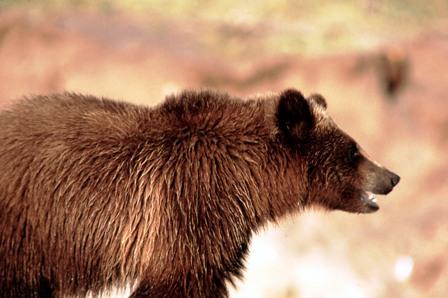A trail runner in Glacier National Park has survived an encounter with two young grizzly bears, although he's got some bite marks to show for it.
The 60-year-old jogger, Thomas Nerison, of Kalispell, Montana, was running along the Lake McDonald Valley Trail on the west side of the park Sunday morning when he heard what sounded like barking dogs and horses coming down the trail.
The jogger told rangers that he was about one to one-and-a-half miles from the Avalanche Lake trailhead about 9:45 Sunday morning when he turned around to hear what was making the noise. Mr. Neirson, who was not making any noise as he ran and who did not have any bear spray with him, told rangers he thought the bears were running from something that had startled them.
One of the bears stopped in close proximity to him and while Mr. Neirson tried to kick the bear, he fell down while doing so. He said the bear the bit him twice as he continued to kick. When the jogger managed to grab some sticks to poke at the bear, the bear lost interest in him, moved back toward the way it had come and then went uphill and away from the trail.
Mr. Neirson then walked downhill and cross country to the Going-to-the-Sun Road where he got a ride from a visitor back to his own car at the Avalanche trailhead. He then drove himself to the Kalispell Regional Medical Center’s Emergency Room for unspecified medical treatment.
Later Sunday rangers closed the trail between the junction with the Avalanche Trail and the Johns Lake Trail, per the park’s bear management policies. Park rangers are investigating the incident and based on their findings, in accordance with Glacier’s Bear Management Guidelines, park managers will determine what, if any, further actions will be taken.
The park is seeking information from anyone who may have been on the Lake McDonald Valley Trail on Sunday between 9 and 10 a.m. Please contact park headquarters at 406-888-7801, if you were on the trail or might have seen bears or dogs in the area between Johns Lake Trailhead and Avalanche Trailhead.
Running on trails and traveling alone in grizzly bear country is not recommended in Glacier. While taking a jog or a run may be good exercise, joggers and runners run the risk of surprising a bear on trails in Glacier. Trail running is discouraged as there have been an increasing number of injuries and fatalities nationwide due to runners surprising bears at close range. Park hikers, trail runners, backpackers and campers are urged to familiarize themselves with standard safety precautions to follow when in bear country.
These precautions include: Never travel alone, never travel after dark, make (loud) reoccurring noise when hiking/walking/trail running (especially near streams, brushy areas, hilltops, and blind curves), keep children close by and within sight, always be aware of local surroundings, keep observant and alert for evidence of bears and mountain lions and/or their activity.
More information about safety in bear country is available on the park’s web site.
“Make no mistake, bears are active,” stated Park Superintendent Chas Cartwrigtht. “All park visitors should be alert while bicycling or simply walking and/or driving along park roads. Running along trails is discouraged because of the potential of surprising a bear. A runner alone on a trail can inadvertently startle or frighten a bear (or mountain lion), causing it to react in a defensive or aggressive manner. Females with cubs are particularly dangerous when they venture from their dens with newborns in the spring.”
"All visitors should keep alert for any signs of bears, make their presence known and keep a safe distance from all bears that are observed," the superintendent added. "DO NOT approach bears or mountain lions under ANY circumstances."
Park managers stress that hikers who have pepper spray should always carry it while in bear country. “Be knowledgeable about how to use bear spray and have it readily accessible and not stowed away in a pack,” urged Superintendent Cartwright.
Bear spray is meant to be used in the case of imminent attacks only and is not intended to be used as a repellent. It should never be sprayed on gear (hiking and/or camping equipment) or around campsites.
“Under no circumstances should pepper spray create a false sense of security or serve as a substitute for standard safety precautions in bear country,” the superintendent added.
This is the first bear-related injury in Glacier since August 2005. In June 1996, a 70-year-old male visitor sustained injuries from a grizzly bear while he was hiking alone on the same trail.
Park visitors are asked to report all sightings (or signs) of bears and/or mountain lion by stopping by or calling park headquarters at 406-888-7800 to report bear and mountain lion sightings as soon as possible.




Comments
Don't be so sensitive. I am sure the runner dude, if he still has a sense of humor, would call himself an idiot and laugh along with others mocking him. He's also a brave dude for fighting those bears. Now he has a great story to tell about the time he was an idiot dumbass who fought a bear. Yay for him!